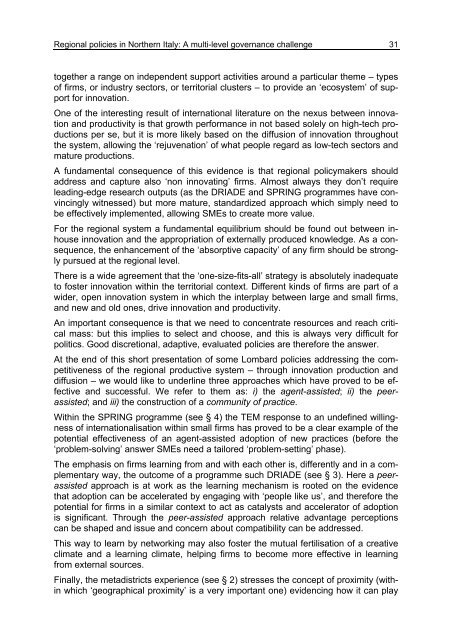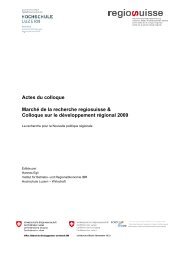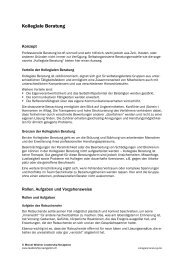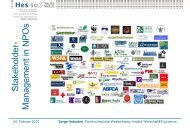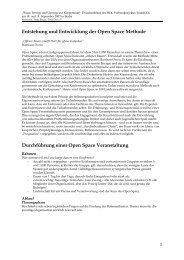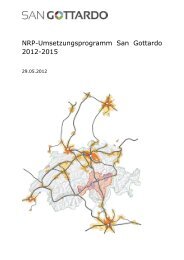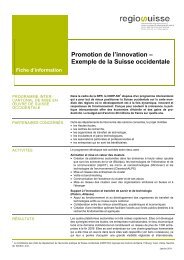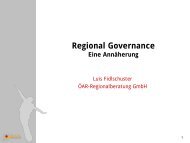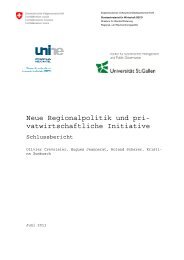Actes du colloque Marché de la recherche regiosuisse & Colloque ...
Actes du colloque Marché de la recherche regiosuisse & Colloque ...
Actes du colloque Marché de la recherche regiosuisse & Colloque ...
Sie wollen auch ein ePaper? Erhöhen Sie die Reichweite Ihrer Titel.
YUMPU macht aus Druck-PDFs automatisch weboptimierte ePaper, die Google liebt.
Regional policies in Northern Italy: A multi-level governance challenge 31together a range on in<strong>de</strong>pen<strong>de</strong>nt support activities around a particu<strong>la</strong>r theme – typesof firms, or in<strong>du</strong>stry sectors, or territorial clusters – to provi<strong>de</strong> an ‘ecosystem’ of supportfor innovation.One of the interesting result of international literature on the nexus between innovationand pro<strong>du</strong>ctivity is that growth performance in not based solely on high-tech pro<strong>du</strong>ctionsper se, but it is more likely based on the diffusion of innovation throughoutthe system, allowing the ‘rejuvenation’ of what people regard as low-tech sectors andmature pro<strong>du</strong>ctions.A fundamental consequence of this evi<strong>de</strong>nce is that regional policymakers shouldaddress and capture also ‘non innovating’ firms. Almost always they don’t requireleading-edge research outputs (as the DRIADE and SPRING programmes have convincinglywitnessed) but more mature, standardized approach which simply need tobe effectively implemented, allowing SMEs to create more value.For the regional system a fundamental equilibrium should be found out between inhouseinnovation and the appropriation of externally pro<strong>du</strong>ced knowledge. As a consequence,the enhancement of the ‘absorptive capacity’ of any firm should be stronglypursued at the regional level.There is a wi<strong>de</strong> agreement that the ‘one-size-fits-all’ strategy is absolutely ina<strong>de</strong>quateto foster innovation within the territorial context. Different kinds of firms are part of awi<strong>de</strong>r, open innovation system in which the interp<strong>la</strong>y between <strong>la</strong>rge and small firms,and new and old ones, drive innovation and pro<strong>du</strong>ctivity.An important consequence is that we need to concentrate resources and reach criticalmass: but this implies to select and choose, and this is always very difficult forpolitics. Good discretional, adaptive, evaluated policies are therefore the answer.At the end of this short presentation of some Lombard policies addressing the competitivenessof the regional pro<strong>du</strong>ctive system – through innovation pro<strong>du</strong>ction anddiffusion – we would like to un<strong>de</strong>rline three approaches which have proved to be effectiveand successful. We refer to them as: i) the agent-assisted; ii) the peerassisted;and iii) the construction of a community of practice.Within the SPRING programme (see § 4) the TEM response to an un<strong>de</strong>fined willingnessof internationalisation within small firms has proved to be a clear example of thepotential effectiveness of an agent-assisted adoption of new practices (before the‘problem-solving’ answer SMEs need a tailored ‘problem-setting’ phase).The emphasis on firms learning from and with each other is, differently and in a complementaryway, the outcome of a programme such DRIADE (see § 3). Here a peerassistedapproach is at work as the learning mechanism is rooted on the evi<strong>de</strong>ncethat adoption can be accelerated by engaging with ‘people like us’, and therefore thepotential for firms in a simi<strong>la</strong>r context to act as catalysts and accelerator of adoptionis significant. Through the peer-assisted approach re<strong>la</strong>tive advantage perceptionscan be shaped and issue and concern about compatibility can be addressed.This way to learn by networking may also foster the mutual fertilisation of a creativeclimate and a learning climate, helping firms to become more effective in learningfrom external sources.Finally, the metadistricts experience (see § 2) stresses the concept of proximity (withinwhich ‘geographical proximity’ is a very important one) evi<strong>de</strong>ncing how it can p<strong>la</strong>y


